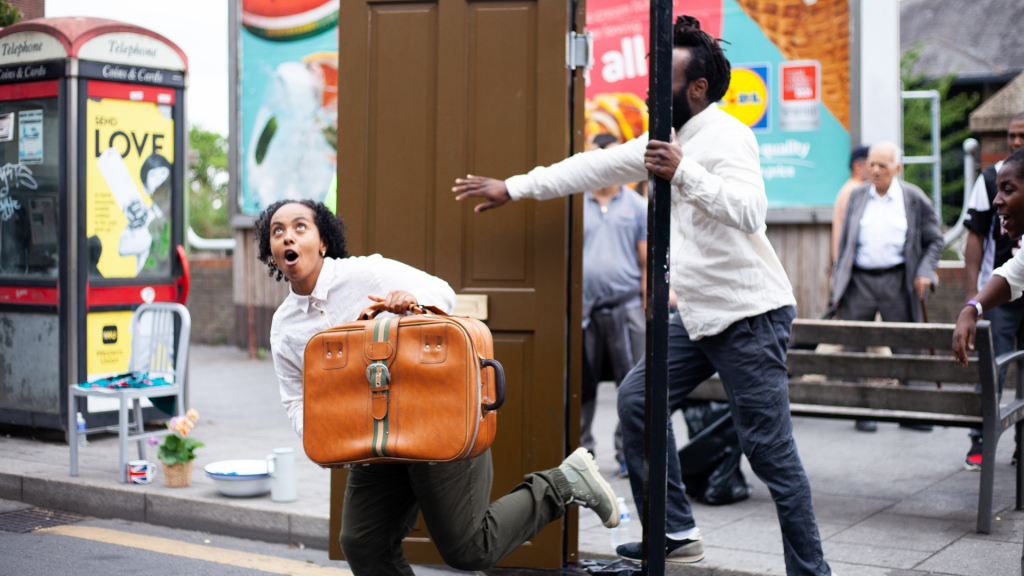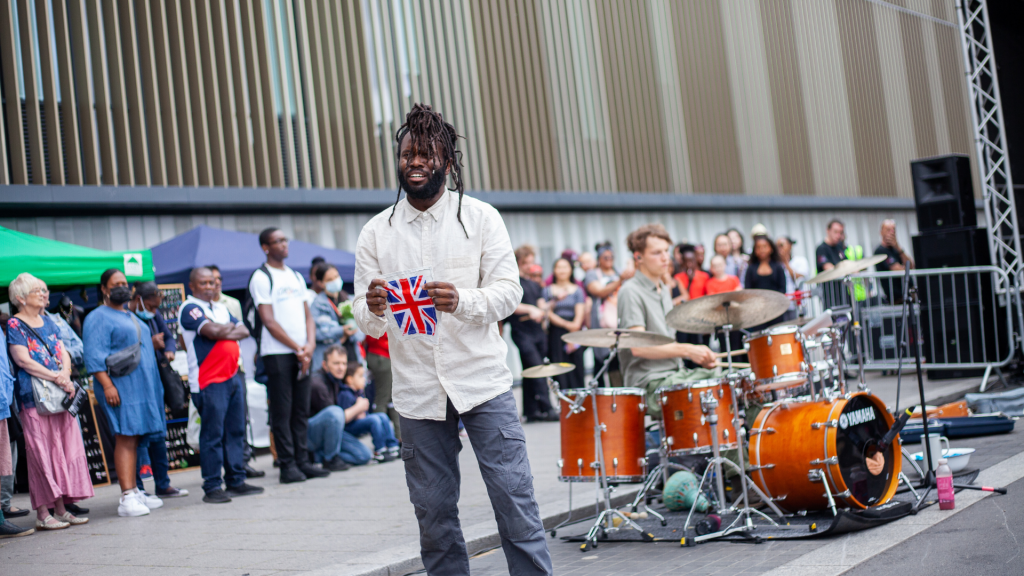Jade Hackett is a performer, actor and choreographer …
As a choreographer/movement director, Jade has worked on Hex at the National Theatre, Get up Stand Up! at the Lyric, White Noise and more; As a performer, her work includes Nine Night at Trafalgar Studios, A Monster Calls on UK tour and Pied Piper at the Barbican She performed as a dancer at London 2012 Olympics Opening Ceremony and Baku 2015 Closing Games, and was the Artistic Director of hip-hop theatre production The Duke Joint at Sadler’s Wells and The Place.
Talawa, the UK’s leading Black theatre company, is now heading on tour with the outdoor production The Tide. Co-created with award-winning writer Ryan Calais Cameron (For Black Boys Who Have Committed Suicide When the Hue Gets Too Heavy). The Tide is a multi-disciplinary production incorporating live music, dance and theatre to explore the experiences of new arrivals in the UK as they navigate a new land.
We talked to Jade ahead of the show’s UK tour…
Please introduce yourself …
My name is Jade Hackett, I’m Black British of Caribbean descent and I’m a Choreographer and Movement Director.
Please share a word or sentence which best describes your life right now.
Striving for a life like the Bees!
The Tide is exclusively designed to be performed outside, when choreographing, did you have to take into account any specific measures for performing outside?
When creating outdoor work there are things that will naturally need to be taken into account. Without the four walls of a room to insulate sound, this was the major thing that needed to be taken into consideration. Cutting down lots of live spoken text and putting it all in the music helps the words to travel further. Making the narrator a drummer equally allows for sound to push out to audiences.
Costume was equally factored within the overall piece. Making sure the footwear can withstand the harder floor surfaces and less restrictive clothing to allow for easy movement. Most of the set design also had to be minimal and reinforced with either carpentry or weights to Anker things to the floor for more stability on potentially uneven grounds.

The Tide was initially performed pre-pandemic in 2019 and again in 2022, have you adapted the piece in any way to reflect the contemporary climate?
Since the last time we performed the show, there have been a lot of social and political shifts in the world. What’s interesting about The Tide is that every time we have put the show on, it invites us to re-evaluate the piece and answer questions about how the change in climate should now affect the piece. With the pandemic, the Palestinian and Ukrainian wars, Black Lives Matter movement and most recently the Rwandan Deportation and Brexit (in respect of the British response to immigration), there were lots of new things and chapters to discuss in the remounting of the show this time around.
The Tide is a combination of dance and poetry. When developing this piece with writer Ryan Calais Cameron, how did you go from conceptualising to realising the show?
Conversations were key in the creation of this piece. In this iteration of the show, the cast is also so varied. With their nationalities being from Jamaica, Uganda, Ethiopia, England, Poland, Palestine and Germany, the conversations around the topic of immigration were vast but most importantly, all came from a place of understanding. Ryan’s observations and words were able to beautifully illustrate the movement that I was creating in the room and Musical and Sound producer Michael was able to integrate this with a beautiful score to accompany it.
You have an impressive list of choreographer/movement director credits, when working on a show, where do you pull movement inspiration from? Who/ what would you say are the key influences on your choreography?
Depending on what I’m choreographing for and why I’m making the art is what source I would draw from. For example, if I’m making a piece centred around social or political issues, aside from reading the facts in books and legal documents, I will also speak to people, to community members or those that are disproportionately affected. It’s the best source of information to be inspired by as the books can’t translate the feeling of the time period outside of the facts. If the piece carries a more self-portraiture-based theme, then I’ll usually start with myself. Asking someone else to question me and get to the root of the theme that I will need to execute the piece. Peeling back the layers to uncover whatever my real internal struggle or joy might be.
One of my all-time key influencers for my work is my Grandmother. I’m blessed to still have her around and all of the historical stories that make up who I am and my heritage and what connects me to the Caribbean are through her. She is the key to my passion.

What’s the most iconic choreographic moment in history for you?
Hex – The Musical at the National Theatre. Having Artistic Director Rufus Norris see my work and deem it fitting for such a large-scale production has been humbling.
You were also a choreographer on the Old Vic’s This is What The Journey Does, which also focuses on migration. Why are you motivated to explore this theme in your art?
I guess the topic of immigration continuously finds me. Lol. To be honest, I rarely take on a project that doesn’t serve me creatively. Whether it’s the subject, or the team involved, I like to work in intensely creative and challenging environments. I’ve been blessed with both projects and fortunate enough to have the perfect atmosphere and minds to work creatively on these pieces of work.
In your short film, Why Do I Love Us So Much, made in response to the murder of George Floyd, you use dance and movement as a form of protest, and you have also referred to yourself as a ‘dance activist’, can you talk more about your artistic practice?
I have felt strongly for a long time now that I wanted to always use my voice to bring awareness, provoke thought and effect change. It’s why dance activism seems so fitting for my artistic practice. I love creating work around members of the black diaspora. Protest does not just look like marching, albeit things that are very necessary for change to occur. I also enjoy creating art around black joy too. Making art that doesn’t sustain the negative monolith image of us in media and film is important.
Why do you think dance is a particularly powerful medium through which to explore Black stories and histories?
Dance is an integral part of black culture. We use movement to connect to everything. Our ancestors, each other and to heal. With the rise of social media forums like Instagram and TikTok with most dancing black creatives being the leading content creators, black movement is undoubtedly a powerful force for connection. It, therefore, feels only right that black stories are illustrated with one of the most powerful languages on the earth. Dance.
The Tide is touring across the UK, how do you hope different audiences respond to the work?
I hope that the living immigrants residing in England feel heard and are given a voice through the piece. Navigation of this country when you are not indigenously from here can feel hard at times and through the piece, I’d want them to know that they are not alone. Likewise, I’d like all British citizens watching the piece to look at their communities with a more accepting heart. Embrace your neighbours. People are people irrespective of what passport document they hold.
Aside from The Tide, do you have any upcoming projects that you are excited about?
Re-mounting of Hex at the National, Associate Choreographer of Sylvia at the Old Vic and a new project with Sadlers Wells Theatre, launching 2025.
GETTING TO KNOW YOU …
- A book you have to have in your collection? I’m currently reading Open Water by Caleb Azumah Nelson. A Black British writer exploring real love stories based in London. It really feels like I’m represented in this novel and love the way that man talks about love. It’s spiritual.
- A song/album that defines the soundtrack of your life to date? This feels like such a loaded question. All music connects with me. I’d have to say though, that currently, the album Who is Jill Scott by Jill Scott is making so much more sense to me with the life experiences that I’m in.
- A film / TV show that you can watch/have watched repeatedly? Film – Another loaded question! There are so many. The Color Purple, Terminator 2, Brown Sugar, Love and Basketball, Apocalypto etc … the list is endless. Guilty pleasure though. Dirty Dancing. “Nobody puts baby in the corner!” lol. TV – Queen Sugar. A brilliant show about family, black people owning land, love, healing and growth, activism, laughter, tears and all the other brilliant emotions in between.
- The first stage production you saw and what it meant to you (play, dance or concert)? Play – it wasn’t my viewed first production, but The Brother Size at the Young Vic will always stay with me. Aside from a brilliantly written script, the staging of it was incredible. Superphysical, super creative and as a result, kept me engaged the whole way through. Dance – Alvin Ailey’s Revelations always comes to mind. Something shifted inside me after watching that organism move as one breath. Beautiful. Also, The Pied Piper by Boy Blue Entertainment. An East London production by two of the leading East London artists in the heart of East London’s Stratford Theatre Royal. An East London extravaganza. My home town. Concert – My earliest memory of a concert was watching Michael Jackson – History Tour. One of the most Iconic concerts I’ve ever seen.
- What’s made you sad, mad, and glad this week? A bereavement of a friend recently. Sadness is followed by anger (or madness) at the cause of their transitioning which is soon followed by the fondness for the memories you hold of them. Glad that at one wonderful point in time, our paths crossed. The process of grief is so powerful and can take a person through a range of different emotions, all within a week.
The Tide is Talwa’s first show ever designed for exclusively outdoor settings and is touring from July-September 2022 at festivals across the UK.
